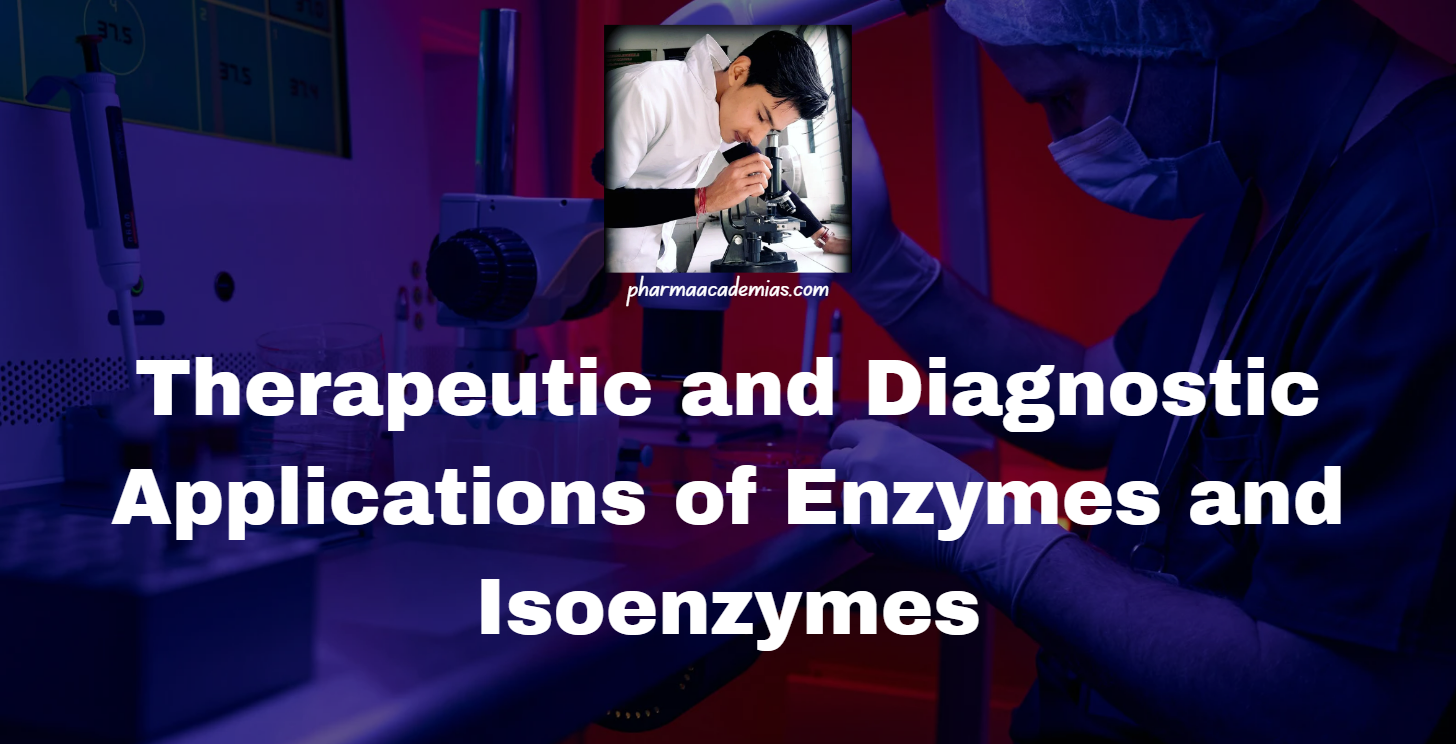Enzymes and isoenzymes play crucial roles not only in metabolism but also in medical diagnostics and therapy. Enzymes can be utilized as drugs to treat specific diseases, while isoenzymes serve as important biomarkers for the diagnosis of various conditions. This note explores the therapeutic and diagnostic applications of enzymes and isoenzymes in detail.
Therapeutic Applications of Enzymes
Enzymes are used therapeutically to replace deficient or absent enzymes in patients, to degrade harmful substances, and to facilitate the breakdown of complex molecules. Here are some key therapeutic applications:
1. Enzyme Replacement Therapy (ERT)
Used to treat genetic disorders where a specific enzyme is deficient or absent.
Example:
Gaucher’s Disease: Patients lack glucocerebrosidase, leading to the accumulation of glucocerebroside. ERT with imiglucerase, a recombinant form of glucocerebrosidase, helps reduce the accumulation.
Pompe Disease: Patients lack acid alpha-glucosidase, leading to glycogen accumulation. ERT with alglucosidase alfa can improve muscle function and reduce glycogen storage.
2. Thrombolytic Therapy
Used to dissolve blood clots in conditions like myocardial infarction, pulmonary embolism, and stroke.
Example:
Streptokinase and Urokinase: These enzymes convert plasminogen to plasmin, which then breaks down fibrin clots.
Tissue Plasminogen Activator (tPA): A recombinant enzyme used in acute ischemic stroke to restore blood flow.
3. Digestive Enzymes
Used to aid digestion in patients with pancreatic insufficiency or other digestive disorders.
Example:
Pancrelipase: A combination of lipase, protease, and amylase used in patients with cystic fibrosis or chronic pancreatitis to improve digestion and nutrient absorption.
4. Enzymes in Cancer Therapy
Used to selectively target and degrade substances that support cancer cell growth.
Example:
Asparaginase: Used in the treatment of acute lymphoblastic leukemia (ALL). It depletes asparagine, an amino acid essential for the growth of leukemia cells.
5. Antioxidant Enzymes
Used to reduce oxidative stress in various conditions.
Example:
Superoxide Dismutase (SOD): Used in conditions like arthritis and inflammatory diseases to reduce damage caused by superoxide radicals.
Diagnostic Applications of Enzymes and Isoenzymes
Enzymes and isoenzymes are critical in diagnostics, particularly as biomarkers for various diseases. Isoenzymes are different forms of an enzyme that catalyze the same reaction but differ in amino acid sequence and physical properties, allowing for tissue-specific identification.
1. Cardiac Enzymes and Isoenzymes
Creatine Kinase (CK) and its Isoenzymes (CK-MB, CK-MM, CK-BB): CK-MB is specific to cardiac muscle and is elevated in myocardial infarction.
Troponin I and T: Cardiac-specific proteins released during myocardial injury, providing high sensitivity and specificity for myocardial infarction diagnosis.
2. Liver Enzymes
Alanine Aminotransferase (ALT): Primarily found in the liver, elevated levels indicate liver damage.
Aspartate Aminotransferase (AST): Found in the liver and other tissues, elevated levels indicate liver or muscle damage.
Gamma-Glutamyl Transferase (GGT) and Alkaline Phosphatase (ALP): Elevated levels are associated with cholestasis and liver diseases.
3. Pancreatic Enzymes
Amylase and Lipase: Elevated levels indicate acute pancreatitis. Lipase is more specific to pancreatic injury.
4. Muscle Enzymes
Lactate Dehydrogenase (LDH): Found in many tissues, including muscle. Elevated levels can indicate muscle damage, hemolysis, or tissue necrosis. LDH isoenzymes help localize the source of damage.
5. Bone Diseases
ALP Isoenzymes: Elevated bone-specific ALP isoenzymes indicate bone disorders such as Paget’s disease, osteomalacia, and bone metastasis.
6. Genetic and Metabolic Disorders
Phenylalanine Hydroxylase: Deficiency indicates phenylketonuria (PKU), a metabolic disorder detected through newborn screening.
Glucose-6-Phosphate Dehydrogenase (G6PD): Deficiency can lead to hemolytic anemia, particularly in response to certain medications, foods, or infections.
Conclusion
Enzymes and isoenzymes are indispensable in both therapeutic and diagnostic contexts. Therapeutically, they are used to replace deficient enzymes, dissolve clots, aid digestion, target cancer cells, and reduce oxidative stress. Diagnostically, enzymes and their isoenzymes serve as vital biomarkers for cardiac, liver, pancreatic, muscle, bone, genetic, and metabolic disorders. Advances in enzyme technology continue to expand their applications, improving disease treatment and diagnostic accuracy. Understanding the roles and mechanisms of these enzymes is essential for developing new therapeutic strategies and diagnostic tools.

